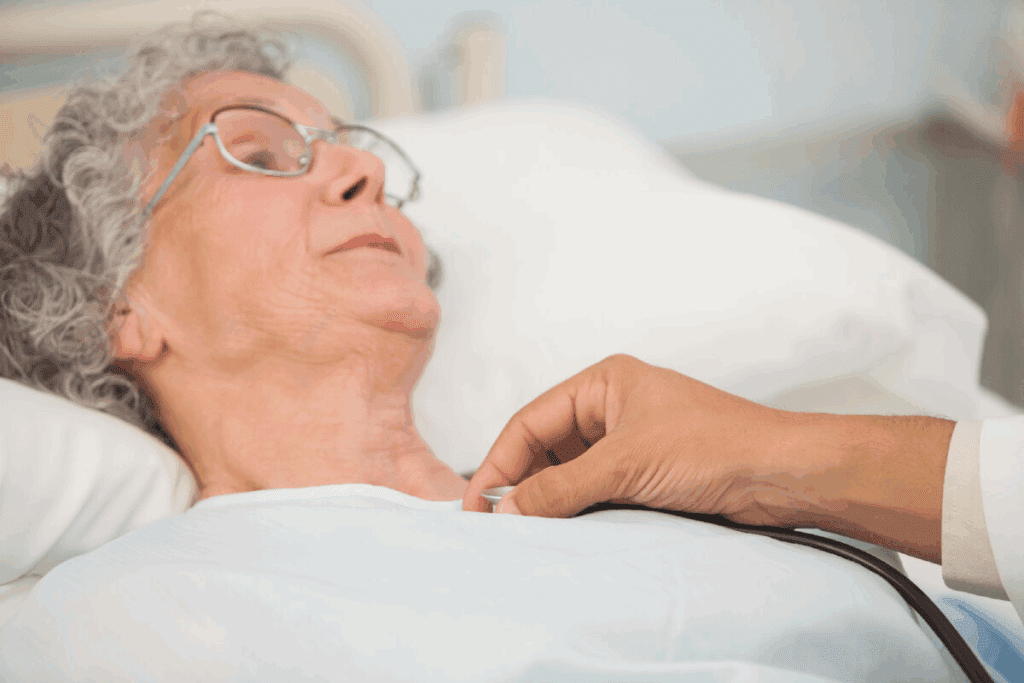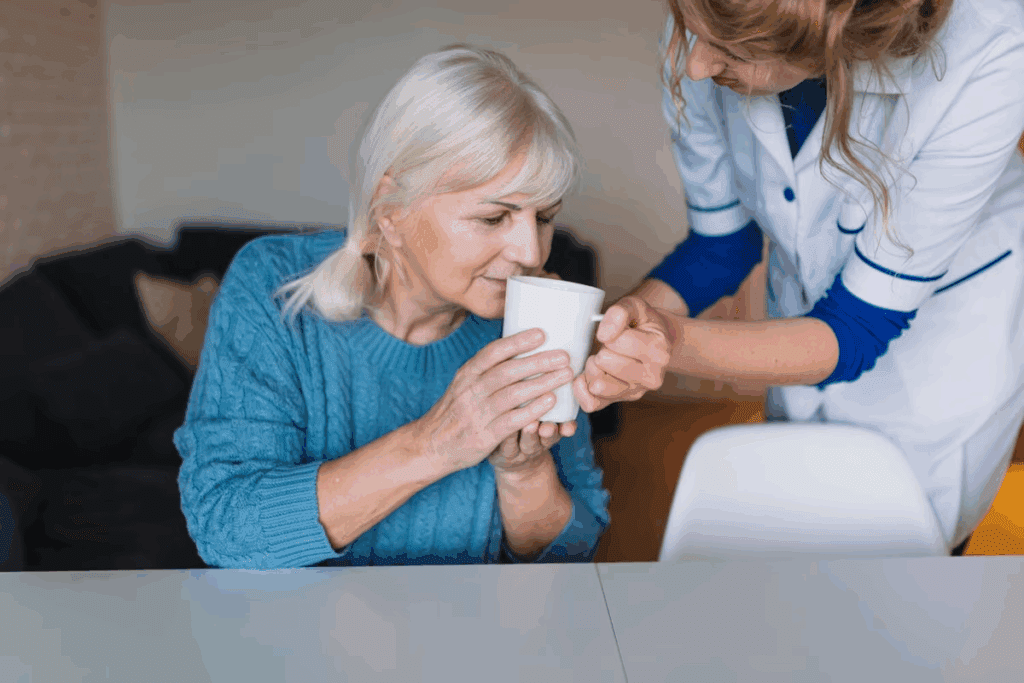Last Updated on October 31, 2025 by Bilal Hasdemir

Urinary tract infections (UTIs) are a big worry for older adults, mainly women. As we get older, the chance of getting UTIs goes up a lot.5 common and sometimes subtle signs of bladder infection in senior women that require prompt attention and treatment.
A 2015 review found that UTIs led to about 10.5 million doctor visits in the U.S. in 2007. More than 10% of women over 65 and almost 30% of women over 85 said they had a UTI in the last year.
We care a lot about the health and happiness of senior women, when it comes to UTIs and bladder infections. It’s very important to get treatment quickly to avoid bigger problems.

It’s important to know about bladder infections in senior women to catch them early. These infections, also known as urinary tract infections (UTIs), are a big health problem for older women. We’ll look into what bladder infections are and why older women are more likely to get them.
A bladder infection happens when bacteria get into the urinary tract and cause an infection. The main bacteria causing UTIs is Escherichia coli (E. coli). UTIs can happen anywhere in the urinary system, like the kidneys, bladder, and urethra. In older women, the bladder is usually where the infection starts.
Studies show that over 10 percent of women over 65 get UTIs every year. This number goes up to nearly 30 percent for women over 85. Women in nursing homes can have even higher rates, from 25 to 50 percent.
| Age Group | Prevalence of UTIs |
| Women over 65 | More than 10% |
| Women over 85 | Nearly 30% |
| Nursing Home Residents | 25 to 50% |
Senior women face a higher risk of bladder infections due to age-related changes. Menopause leads to lower estrogen levels, making the vaginal and urethral tissues thinner. This makes it easier for bacteria to cause infections. Other factors include:
Estrogen therapy is sometimes used to help prevent UTIs in postmenopausal women. It helps keep the vaginal and urethral tissues healthy.

Urinary tract infections (UTIs) are a big health worry for elderly women, mainly in nursing homes. As we get older, the chance of getting UTIs goes up. Women over 65 face a higher risk. We’ll look at the numbers and why nursing home residents are at greater risk.
Older adults, and women in particular, are more likely to get UTIs. This is because of changes in their bodies. Studies show that women over 65 get UTIs more often than younger women. This is due to factors like catheter use, incontinence, and health issues.
To grasp how common UTIs are, here are some numbers:
| Age Group | UTI Incidence Rate | Common Risk Factors |
| 65-74 years | 10-15% | Incontinence, catheter use |
| 75-84 years | 15-20% | Diabetes, urinary retention |
| 85+ years | 20-25% | Nursing home residence, dementia |
Nursing home residents face a higher risk of UTIs. Factors like catheter use, poor hygiene, and health issues play a big role. The shared living space also makes infections spread easier.
It’s important to act fast and prevent UTIs in elderly women, mainly in nursing homes. Knowing the risks helps healthcare workers improve care for this group.
Painful urination is a common sign of bladder infections in elderly women. This discomfort, known as dysuria, feels like burning or pain while you pee. It’s important to pay attention to this symptom, as it can really affect your life.
In older women, dysuria can feel different. The pain might be mild or very severe. It can also be accompanied by other symptoms like needing to pee a lot or right away.
Many things can affect how dysuria feels, like changes after menopause or past health issues. Knowing these can help doctors diagnose and treat bladder infections better.
It’s important to tell UTI pain from other urinary problems. Issues like interstitial cystitis, stones, or gynecological problems can cause similar symptoms. Doctors need to do tests like urinalysis and imaging to make sure.
Some elderly women might not show typical symptoms, making it harder to diagnose. Being careful and thorough is key to spotting bladder infections in this group.
A common sign of bladder infection in older women is sudden, frequent need to urinate. These symptoms can really disrupt daily life, causing a lot of discomfort. It’s important to know when these changes mean you might have a bladder infection.
As women get older, their urination habits can change. This is due to hormonal shifts and age-related changes in the urinary tract. A sudden increase in needing to urinate often is a warning sign of a bladder infection. Elderly women may experience:
These changes can be upsetting and affect daily activities. It’s key to tell normal age-related changes from signs of a bladder infection.
When elderly women have more frequent and urgent urination, it’s important to check if it’s a bladder infection. Key indicators include:
Spotting these signs early can help get treatment quickly and avoid bigger problems. We stress the need to watch urinary health and see a doctor if symptoms don’t go away or get worse.
In summary, more frequent and urgent urination are big signs of a bladder infection in elderly women. By understanding these changes and their meanings, we can take better care of urinary health. This improves the quality of life for older women.
Sign #3: Changes in Urine Appearance and Odor
Changes in urine can signal a bladder infection in elderly women. Bacteria in the urinary tract can make urine look and smell different.
One sign of a bladder infection is urine that looks different. Normally, urine is clear or pale yellow. But when infected, it might:
A strong or odd smell can also mean a bladder infection. Bacteria in the urinary tract can make urine smell:
Senior women and their caregivers should watch for these signs. They are important clues of a bladder infection that needs medical help.
Senior women often feel tired and unwell due to bladder infections. These feelings can make simple tasks hard. It’s a big problem for their daily life.
When the body fights off a bladder infection, it gets very tired. We’ll look into how this happens and why it’s a big worry for older women.
Bladder infections don’t just affect the bladder. They can make you feel tired and unwell all over. This is because the body’s fight against the infection affects your overall health.
For older women, this can be really tough. It can make their health problems worse. It’s important to see these signs as possible bladder infection symptoms.
Telling if tiredness is from a UTI or just getting older is hard. But, UTI-related fatigue often comes with other signs like changes in how you pee or pain when you pee.
We need to watch for these signs and not just think they’re from getting older. Quick diagnosis and treatment can really help improve the lives of older women with bladder infections.
Confusion and changes in behavior can signal a bladder infection in elderly women, even more so if they have cognitive issues. These symptoms are worrying for both patients and their caregivers. It’s important to see how they relate to urinary tract infections (UTIs).
UTI-related delirium is when a bladder infection suddenly changes a person’s mental state. This can lead to confusion, disorientation, and different behavior. It’s more common in older adults, and those with dementia or other health problems. Key symptoms include:
It’s key to see these symptoms as signs of a bladder infection, not just age-related cognitive decline.
Mental status changes in elderly women with bladder infections happen for several reasons. The infection can trigger a body-wide inflammatory response. This can affect the brain, causing confusion and delirium. Also, it can make existing cognitive problems worse, so it’s vital to watch patients closely.
Factors contributing to mental status changes include:
Knowing these factors helps healthcare providers diagnose and treat UTIs better. This can reduce complications and improve patient outcomes.
Risk Factors and Complications of Untreated UTI in Elderly Women
It’s important to know the risk factors for UTIs in elderly women to avoid complications. As women get older, their bodies change in ways that make them more likely to get UTIs.
After menopause, estrogen levels drop, affecting the urinary tract. Estrogen deficiency makes vaginal and urethral tissues thinner and less elastic. This makes them more likely to get infected.
Postmenopausal women often face urinary incontinence too. This can raise the risk of UTIs because the bladder doesn’t empty fully, allowing bacteria to grow.
Some chronic health conditions raise the risk of UTIs in elderly women. For example, diabetes is a big risk factor. High blood sugar levels can make urine sweet, attracting bacteria.
These conditions make it harder for the body to fight off infections. They often need extra care to manage UTI risk.
Untreated UTIs can cause serious problems in elderly women. One big worry is urosepsis, a dangerous condition where bacteria from the urinary tract get into the blood.
Other serious issues include kidney damage, recurring UTIs, and a higher chance of falls. These can happen because of UTI-related confusion or delirium. We stress the need for quick treatment to avoid these problems and keep elderly women safe.
Treating bladder infections quickly is key for elderly women’s health. We’ve learned that not treating them can lead to serious problems. Antibiotics are often used to fight UTIs, helping to ease symptoms and prevent worse issues.
Healthcare providers can offer timely and effective treatment by knowing the signs and risks of bladder infections. Spotting symptoms like painful urination and frequent trips to the bathroom early is important. This allows for quick action to treat UTIs, reducing the chance of complications and improving health.
When caring for elderly women, we must focus on their urinary health. We need to watch for signs of bladder infections and act fast to treat them. This approach helps ensure elderly women stay healthy and happy, giving them the care they need to live well.
Signs include painful or burning urination and needing to urinate more often. You might also notice changes in urine color or smell. Feeling tired, confused, or acting differently are other signs.
Senior women face a higher risk due to changes with age. Lower estrogen levels can make tissues thinner, making infections more likely.
Risk factors include changes after menopause and chronic health issues. Living in nursing homes also increases the risk.
Infections can cause confusion and changes in behavior, which is why it’s important to recognize these signs. This helps in getting timely treatment.
Untreated UTIs can lead to serious issues like kidney damage or sepsis. This shows why quick treatment and care are critical.
Providers diagnose UTIs by looking at symptoms like painful urination. They also do tests to confirm bacterial infections.
Women over 65 face a higher risk of UTIs. Those in nursing homes are at even greater risk. This highlights the need for prevention and timely treatment.
Yes, UTIs can lead to unusual fatigue and malaise. These symptoms can greatly affect an elderly woman’s life. It’s important to recognize them as signs of infection, not just age-related tiredness.
Changes like cloudy or bloody urine and strong smells suggest bacterial growth. These signs need immediate medical attention.
Quick treatment is key to avoid complications and improve quality of life. It’s vital for elderly women with bladder infections.
National Center for Biotechnology Information. 5 Signs of Bladder Infection in Senior Women https://www.ncbi.nlm.nih.gov/pmc/articles/PMC4194886
Subscribe to our e-newsletter to stay informed about the latest innovations in the world of health and exclusive offers!
WhatsApp us